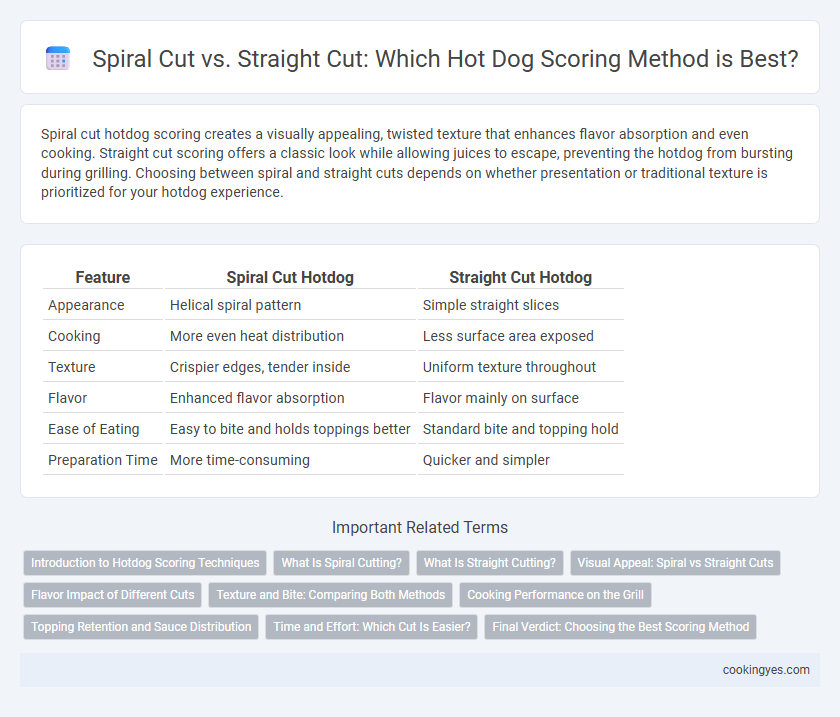Spiral cut hotdog scoring creates a visually appealing, twisted texture that enhances flavor absorption and even cooking. Straight cut scoring offers a classic look while allowing juices to escape, preventing the hotdog from bursting during grilling. Choosing between spiral and straight cuts depends on whether presentation or traditional texture is prioritized for your hotdog experience.
Table of Comparison
| Feature | Spiral Cut Hotdog | Straight Cut Hotdog |
|---|---|---|
| Appearance | Helical spiral pattern | Simple straight slices |
| Cooking | More even heat distribution | Less surface area exposed |
| Texture | Crispier edges, tender inside | Uniform texture throughout |
| Flavor | Enhanced flavor absorption | Flavor mainly on surface |
| Ease of Eating | Easy to bite and holds toppings better | Standard bite and topping hold |
| Preparation Time | More time-consuming | Quicker and simpler |
Introduction to Hotdog Scoring Techniques
Hotdog scoring techniques, such as spiral cut and straight cut, significantly influence cooking efficiency and flavor absorption. Spiral cuts increase surface area, promoting even cooking and better integration of seasonings or sauces, while straight cuts provide simple, clean slices ideal for controlled browning. Selecting the appropriate scoring method enhances texture and taste, catering to specific culinary preferences and preparation styles.
What Is Spiral Cutting?
Spiral cutting involves slicing the hotdog in a continuous helical pattern, creating a spiral groove around its surface that enhances flavor absorption and cooking efficiency. This method increases the surface area exposed to heat, resulting in a crispier texture and more even cooking compared to straight cuts. Spirally scored hotdogs also hold condiments better, making the eating experience more flavorful and convenient.
What Is Straight Cutting?
Straight cutting for hotdog scoring involves making a single slice lengthwise along the bun or sausage, creating a uniform seam that allows toppings to settle evenly. This method enhances the hotdog's structural integrity while ensuring consistent cooking and flavor absorption. Straight cuts provide a classic presentation, making them ideal for traditional hotdog preparation.
Visual Appeal: Spiral vs Straight Cuts
Spiral cuts create a dynamic, eye-catching helix pattern that enhances the visual appeal of hotdogs by adding texture and dimension, making them stand out on the plate. Straight cuts offer a classic, uniform look with evenly spaced slices that emphasize simplicity and consistency in presentation. The spiral cut's intricate design tends to draw more attention and elevate the overall aesthetic compared to the straightforward, linear appearance of straight cuts.
Flavor Impact of Different Cuts
Spiral cut scoring creates increased surface area on a hotdog, allowing marinades, spices, and grill heat to penetrate deeper, enhancing overall flavor intensity. Straight cut scoring produces distinct bite-sized segments that crispen differently on the grill, providing varied texture and a balanced taste in each bite. These cutting techniques significantly influence the flavor release and texture experience when grilling hotdogs.
Texture and Bite: Comparing Both Methods
Spiral cut hotdogs create a unique texture by increasing the surface area, resulting in more crispiness and an enhanced bite experience compared to straight cut scoring. The spiral scoring allows flavors from condiments and grill marks to penetrate deeper, offering a juicier, more flavorful hotdog. In contrast, straight cut scoring provides a classic, firmer texture with less surface crunch, appealing to those who prefer a more traditional bite.
Cooking Performance on the Grill
Spiral cut hotdogs provide enhanced cooking performance on the grill by increasing surface area, allowing for more even heat distribution and faster cooking times. Straight cut scoring offers focused areas for fat rendering and caramelization but may cook less uniformly compared to spiral cuts. Grill marks and texture development are more pronounced with spiral cuts, improving flavor and crispness.
Topping Retention and Sauce Distribution
Spiral cut hotdogs create grooves that enhance topping retention by providing more surface area and preventing slippage, while also promoting even sauce distribution along the entire length. Straight cut scoring produces uniform channels that allow toppings and sauces to pool at regular intervals, offering concentrated bursts of flavor. Choosing between spiral and straight cuts depends on whether consistent coverage or distinct topping pockets are preferred.
Time and Effort: Which Cut Is Easier?
Straight cut scoring requires less time and effort due to its simple, linear slicing technique, making it ideal for quick preparation. Spiral cut scoring, while visually appealing and enhancing flavor absorption, demands more precision and time to execute properly. Choosing straight cuts maximizes efficiency in busy kitchens, whereas spiral cuts are better suited for leisurely cooking and presentation.
Final Verdict: Choosing the Best Scoring Method
Spiral cut scoring enhances the hotdog's surface area, allowing for more even cooking and improved texture with a visually appealing presentation. Straight cut scoring offers simplicity and preserves the hotdog's juiciness by limiting the exposed surface, making it ideal for traditional grilling methods. Choosing between spiral and straight cut scoring depends on desired texture, cooking technique, and presentation preferences.
Spiral cut vs Straight cut for hotdog scoring Infographic

 cookingyes.com
cookingyes.com